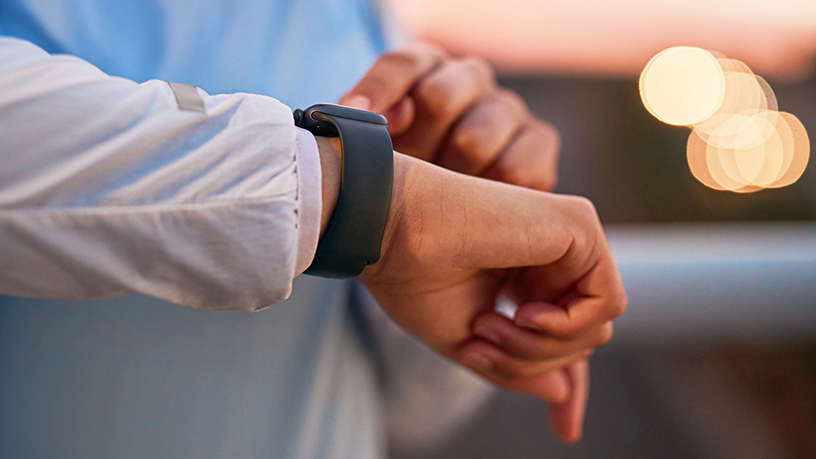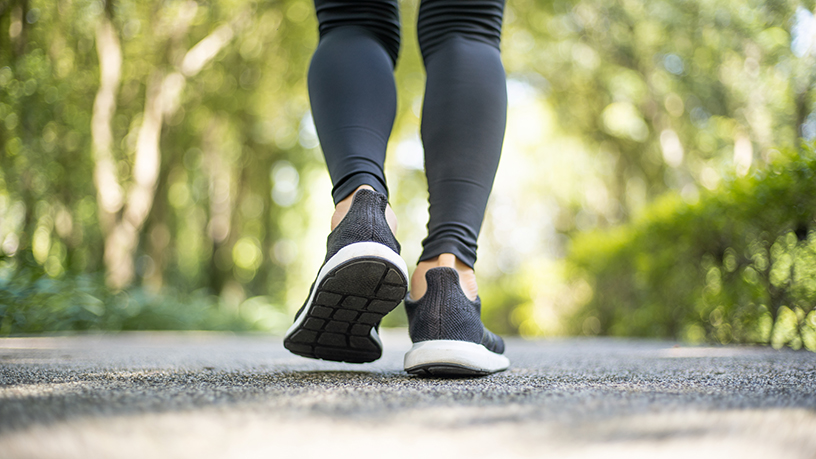On this page
Key takeaways
- A daily walk can significantly lower your risk of serious illness, including heart disease and type 2 diabetes.
- Getting your daily steps may also help manage your weight, build strength and improve your mental health.
- Picking up the pace or trying interval training may increase the benefits to your mind and body.
It might not feel like much of a workout, but stepping up your daily strides is one of the easiest ways to take care of your health and wellbeing.
Physiotherapist Nadeena Thenabadu explains why walking is a health hero, and how you can make the most of every step.
The unsung health hero
Daily intentional walking can have a profound impact on your health. Research shows it can lower your risk of early death from various causes.1
It’s not only convenient but also adaptable to suit various fitness levels and lifestyles says Nadeena Thenabadu, Owner and Head Physiotherapist of Melbourne’s Head2toe Physiotherapy and Podiatry.
“Walking mainly works through the cardiorespiratory system,” says Nadeena. “It's exercise for the heart and lungs, which knocks on to a range of benefits to your body.”
Nadeena shares 4 ways walking can improve your health and how you can step up your daily stroll.
1. Lower your risk of disease
When you make walking a regular part of your life, you reduce your risk of serious diseases.
One study suggests walking for 30 minutes 5 days a week can reduce your risk of heart disease by close to 20%2 and lower your risk of type 2 diabetes by around 30%.3
Walking can also help you manage your blood pressure and cholesterol and reduce the risk of stroke by improving circulation and strengthening the heart.
When combined with a nutritious diet, walking can be a powerful tool to help improve your cardiovascular health.
2. Improve your muscle and bone health
Walking taps into stored energy in your body, primarily from carbohydrates and fats, and engages multiple muscle groups, especially your legs.4
“Whether that's the calves or the quadriceps, walking is a great exercise to help maintain and sometimes even improve the muscle mass in the lower body,” says Nadeena.
Walking can also improve your bone health, says Nadeena.
“Applying a little low impact-based loading on the bone causes denser bones to occur.”
This is great for things like osteoporosis management, which is especially important if you’re perimenopausal or postmenopausal.
3. Manage pain
Walking can help to manage pain, particularly where the lower back is concerned, says Nadeena.
“[For] people living in chronic pain, it's one of our best interventions. Just the gentle motion of walking itself is a stretch for the back.This can help reduce inflammation [and] tightness around the area.”
This may be particularly important for people living with musculoskeletal problems, where there's shoulder, hip or knee pain.
“Pain management by walking is quite significant because of that endorphin release, [which] actually reduces musculoskeletal pain,” says Nadeena.
4. Improve your mood
Walking has been found to boost your mood and improve mental health issues like anxiety and depression. “We know there is positive hormone release through just exercise, and especially walking,” says Nadeena.
A 2022 study found 2.5 hours of brisk walking every week may reduce your risk of depression by 25%.5
It can provide immense psychological benefit and aid in management of things like depression and anxiety.
Taking a walk is a wonderful way to incorporate mindfulness into your daily routine and offers an opportunity to connect with nature.
Sharing a walk with others will add a layer of social connection to your exercise. Strong social connections are known to play a pivotal role in your physical and mental wellbeing.
Connecting with others may help you manage stress, anxiety, and depression, make healthier lifestyle choices and perhaps even improve your sleep.6
Does walking count as your daily cardio?
Yes. Regular, consistent physical activity is at the heart of staying healthy. But this all depends on how you’re doing it, says Nadeena.
“If you're going for just a leisurely paced walk, it would be classified as low to moderate in intensity exercise based on Australian physical activity guidelines.”
Its recommended adults aged between 18 and 64 do at least:
- 2.5 to 5 hours of moderate or
- 1.25 to 2.5 hours of vigorous exercise per week.7
The guidelines recommend mixing moderate walking with more intense cardio like running or cycling. You can also speed up your walk for added intensity.
“If you go for a faster walk where you actually push yourself a little bit, that can have some additional benefits when it comes to muscle gain, bone loading [and] improving cardiorespiratory fitness,” says Nadeena.
Alternatively, you can incorporate a mix of both moderate and vigorous walking into the same stroll. ‘Interval walking training’ (IWT) is becoming more popular.
It may help you:
- improve overall fitness
- build muscle strength
- reduce your risk of health conditions including type 2 diabetes and high blood pressure
- manage diabetes.8
IWT involves walking quickly for 3 minutes (using around 70% of your maximum output), then walking slowly for 3 minutes (using around 40% effort). You can then repeat this throughout your walk, alternating back and forth for half an hour or so.9
Making walking a part of your routine
Whichever path you choose to walk down, the goal should be to make it a part of your everyday routine.
“There's nothing that's going to increase your step count more rapidly than actually doing an intentional walk,” Nadeena says.
Getting in the right amount of steps for you each day can be as simple as going for a 20-minute stroll or even taking a few shorter walks throughout the day.
While shorter, incidental walks will all add up, intentional walks are an ideal way to boost your step count, your mood and your overall health, one step at a time.

At Bupa, trust is everything
Our health and wellbeing information is regularly reviewed and maintained by a team of healthcare experts, to ensure its relevancy and accuracy. Everyone's health journey is unique and health outcomes vary from person to person.
This content is not a replacement for personalised and specific medical, healthcare, or other professional advice. If you have concerns about your health, see your doctor or other health professional.
1Paluch, A. E., Gabriel, K. P., Fulton, J. E., Lewis, C. E., Schreiner, P. J., Sternfeld, B., & Sidney, S. (2022). Daily steps and all-cause mortality: A meta-analysis of 15 international cohorts. The Lancet Public Health, 7(3), e219-e228.
2Zheng, H., Orsini, N., Amin, J., Wolk, A., Nguyen, V. T., & Ehrlich, F. (2009). Quantifying the dose-response of walking in reducing coronary heart disease risk: meta-analysis. European journal of epidemiology, 24(4), 181-192.
3Jeon, C. Y., Lokken, R. P., Hu, F. B., & van Dam, R. M. (2007). Physical activity of moderate intensity and risk of type 2 diabetes: a systematic review. Diabetes care, 30(3), 744-752.
4Yamada, S., & Sato, D. (2024). Relationship between metabolic cost, muscle moments and co-contraction during walking. Journal of Physiological Anthropology
5Pearce M, Garcia L, Abbas A, et al. (2022). Association Between Physical Activity and Risk of Depression: A Systematic Review and Meta-analysis. JAMA Psychiatry, 79(6):550-559.
6Centers for Disease Control and Prevention. (n.d.). About social connectedness.
7Department of Health and Aged Care. (2021, May 7). Physical activity and exercise guidelines for all Australians. Australian Government.
8Karstoft, K., Thorsen, I.k, Nielsen, J.s, Solomon, T. P. J., Masuki, S., Nose, H., & Ried-Larsen, M. (2024). Health benefits of interval walking training. Applied physiology, nutrition, and metabolism = Physiologie appliquee, nutrition et metabolisme, 49(7), 1002-1007.
9Masuki, S., Morikawa, M., & Nose, H. (2019). High-Intensity Walking Time Is a Key Determinant to Increase Physical Fitness and Improve Health Outcomes After Interval Walking Training in Middle-Aged and Older People. Mayo Clinic proceedings, 94(12), 2415-2426.
You might also like
Why 10,000 steps? A simple path to a healthier you
You’ve probably heard that 10,000 steps a day is important for your health, but have you ever stopped to ask why?
The mental health benefits of walking
Walking is one of the best things you can do for your body. It’s also great for your mind.
5 ways to track your steps
Tracking your steps can be simple with the right tool. Discover 5 easy ways to make sure you’re hitting your targets.
4 ways to sneak more steps into your day
It can feel hard to get in those 10,000 steps in this busy world. But it might be easier than you think.





